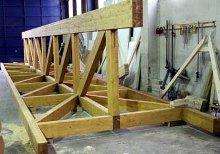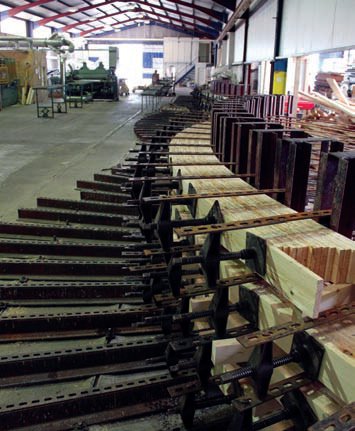Bucking the glulam trend
5 April 2014Buckland Timber represents a rare commodity in the UK - a domestic producer of glulam beams. Stephen Powney reports.
UK glulam beam manufacturers are few and far between, with imported products from the Nordic countries and central Europe dominating.
So the launch of Buckland Timber last year following an investment in glulam production equipment was certainly an eyebrow raiser.
Buckland makes a bold claim, saying it is the only British company capable of manufacturing glulam on a scale that can make its product competitive with imports.
The other UK companies currently manufacturing glulam beams tend to be small volume operations focusing on bespoke projects; or companies with design and machining facilities, using imported glulam to produce structures and components for the construction sector, as well as supply commodity straight beams.
Buckland represents an interesting alliance - Bill Blight and Ralph Nicholson are both south-west forest owners/managers, while Ralph's son Robin is a structural engineer.
None has a background in manufacturing but all recognised that glulam use was increasing rapidly.
The Devon business was founded with heavy investment in machinery, including sawing equipment, a large-scale finger-jointing machine and press technology.
The factory spans 1,800m² and production capacity is 5,000m³ annually (straight beam capacity), with seven production workers and two designers.
"In most countries there are a lot of small glulam manufacturers that cater for the bespoke client," said director Robin Nicholson.
"There's no real reason why we shouldn't have some of these in the UK. We see a lot of requests for curved beams and portal frames. There's a lot of demand and we are having to push to keep up with quotations.
"At the beginning we were trying to compete on price but we are now finding that we have enough of the bespoke work that we're not having to do that."
Buckland's focus is private end users, architects and builders, not the commodity beams market.
Mr Nicholson admits it is difficult to compete against major Austrian, German and Nordic glulam producers on large-volume standard straight beams.
"But as soon as it's curved or out of the ordinary we are more competitive," he said. He also sees potential for Buckland in the supply of non-standard straight beams in small volumes and at short notice.
And he views the combination of beam production and an in-house design team to complete all the construction detailing and sourcing of steelwork for the end user as a benefit.
Originally, the intention was to use mainly home-grown timber but Buckland is focusing on machine-graded C24 Scandinavian spruce and Siberian larch to manufacture GL24 glulam beams. Some volumes of home-grown larch are also being sourced.
Mr Nicholson said the wide growth rings and pinkish appearance of the home-grown larch were striking and the company has secured a grant to carry out testing on the material. It has so far completed several small canopy structures using the species.
Beams can be fabricated up to 27m long, in 90-250mm widths and 180-1800mm deep, comprising between 4 and 40 laminations.
Buckland's finger-jointing machine is capable of cutting a finger-joint through the full depth of a glulam beam, making it possible to connect two glulam beams together with a finger-joint. Certification is currently being explored for this use.

